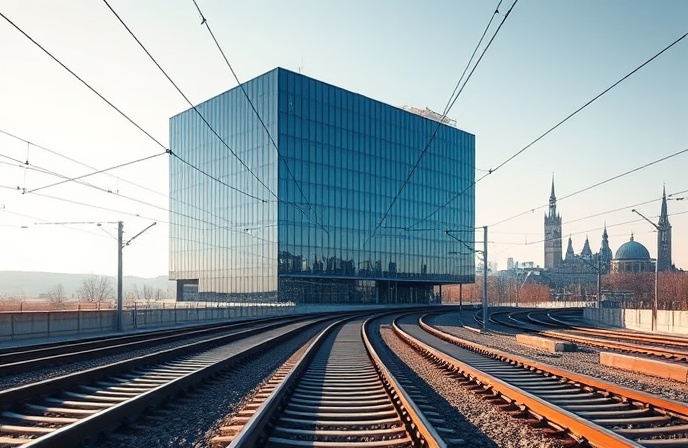India’s RRTS Project: High-Speed Rail’s Future
Transforming railway infrastructure? Discover how intelligent systems, sustainable practices, and high-speed rail are revolutionizing the future of rail travel!

The Future of Railway Infrastructure: A Deep Dive into Modernization and Expansion
The global railway industry is undergoing a period of significant transformation, driven by technological advancements, evolving passenger demands, and the pressing need for sustainable transportation solutions. This article delves into the key aspects of modernizing existing railway infrastructure and exploring expansion initiatives, focusing on the vital role of efficient planning, intelligent systems, and sustainable practices. From enhanced safety features to optimized operational efficiency, the railway sector is embracing innovation to provide a superior and eco-friendly travel experience. This examination considers the complexities involved, addressing challenges, and highlighting the opportunities within this dynamic landscape. Specific attention will be paid to high-speed rail development and its contribution to faster commutes and improved connectivity, along with exploring the integration of cutting-edge technologies like AI and IoT in enhancing the operational efficacy of rail systems. The future of rail travel hinges on careful planning and strategic investments in infrastructure development and innovative technologies.
Planning and Design for Efficient Rail Systems
Effective planning and design are foundational to the success of any railway project. Careful consideration of factors like land acquisition, environmental impact assessments, and community engagement are critical to minimizing disruptions and fostering public support. Detailed route planning must incorporate thorough traffic modeling and capacity assessments to optimize track layout and ensure the network’s future viability. Sustainable design principles, including the use of recycled materials and energy-efficient technologies, should be prioritized to create environmentally responsible infrastructure. This includes considering the long-term impact on ecosystems and communities.
Intelligent Systems and Automation in Railway Operation
Automation and the integration of intelligent systems are transforming railway operations. From advanced signaling systems utilizing real-time data to automated train control, these technologies enhance safety, improve punctuality, and optimize resource allocation. Predictive maintenance, enabled by sensor technology and data analytics, can minimize disruptions by identifying potential equipment failures before they occur. Real-time monitoring of train operations, coupled with intelligent traffic management systems, further improves efficiency by adjusting schedules and resources to dynamic conditions. This level of sophistication allows for more flexible and resilient railway systems, adaptable to changing demand and unforeseen events.
Sustainable Practices in Railway Infrastructure
Sustainability is no longer a niche concern in the railway industry; it’s a core component of responsible development. The focus extends beyond reducing emissions to encompass the entire lifecycle of the rail infrastructure, including the sourcing of sustainable materials, minimizing environmental impact during construction, and implementing energy-efficient technologies throughout the system. The use of renewable energy sources, such as solar power and wind turbines, coupled with energy-efficient train designs, significantly reduces the carbon footprint of rail operations. The adoption of green technologies plays a vital role in ensuring the long-term viability and environmental responsibility of railway infrastructure.
The Future of High-Speed Rail and the RRTS Project India
High-speed rail (HSR) networks offer a significant leap forward in passenger transportation, combining speed, comfort, and efficiency. The planning and construction of HSR projects require meticulous attention to detail, addressing issues such as land acquisition, environmental mitigation, and infrastructure compatibility. HSR lines often necessitate significant investment in infrastructure, including elevated tracks, dedicated right-of-ways, and high-capacity stations. These projects play a crucial role in boosting economic activity, fostering regional connectivity, and enhancing the overall quality of life for citizens. The successful implementation of high-speed rail lines depends on careful planning, significant financial investment, and a thorough understanding of the community’s needs. The RRTS project in India, for example, is a testament to the potential for high-speed rail to significantly enhance urban mobility and connectivity in densely populated areas. The introduction of cutting-edge technologies, such as advanced signalling, smart station design, and efficient energy systems, is essential for the effective operation and management of such high-speed rail networks.
Conclusions
This analysis of modernizing and expanding railway infrastructure underscores the critical role of strategic planning, intelligent systems, sustainable practices, and high-speed rail development. Effective planning considers community needs and environmental impact assessments. Intelligent systems such as advanced signaling and automated control optimize operational efficiency and safety. Integrating sustainable practices across the project lifecycle minimizes environmental impact. The introduction of high-speed rail (HSR) networks facilitates faster commutes and improved connectivity. The example of the RRTS project India highlights the importance of such initiatives in transforming urban transportation. These improvements not only enhance passenger experience but also stimulate economic growth, foster regional development, and contribute to a more sustainable future. While challenges exist, the potential for railway modernization is vast, presenting substantial opportunities to meet future transportation demands, and significantly contributing to the global movement toward sustainable mobility. By embracing these technologies and approaches, railways can play a crucial role in shaping a better future for transportation worldwide.
You might be interested in:



